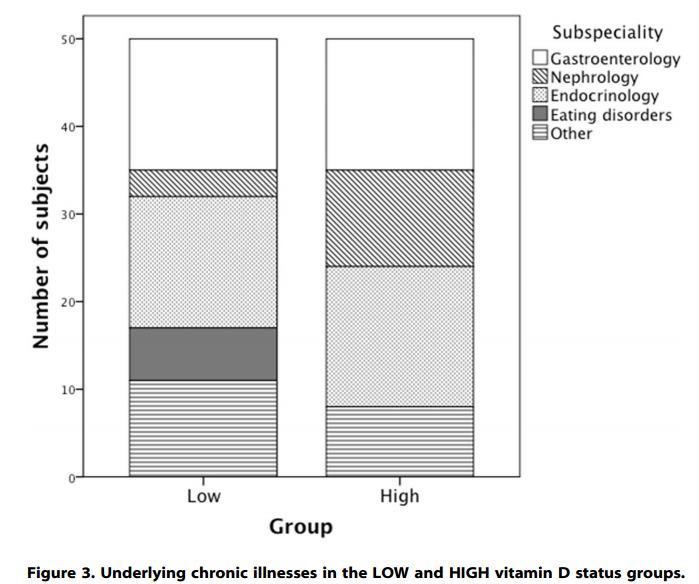Half of children with chronic illness had low levels of vitamin D
Vitamin D Deficiency in Children with a Chronic Illness–Seasonal and Age-Related Variations in Serum 25-hydroxy Vitamin D Concentrations
PLoS One. 2013; 8(4): e60856. Published online 2013 April 9. doi: 10.1371/journal.pone.0060856
Elisa Holmlund-Suila,#1 Panu Koskivirta,#1 Tuula Metso,2 Sture Andersson,1 Outi Mäkitie,1,4 and Heli T. Viljakainen1,3,*
Introduction: Children and adolescents with a chronic illness have potential risk factors for vitamin D deficiency. An optimal vitamin D status might have multiple health effects. This study evaluated vitamin D status and its association with age, gender, and season in a large cohort of chronically ill Finnish patients at a tertiary pediatric outpatient clinic. A cross-sectional register-based study was carried out, involving altogether 1351 children (51% boys, age range 0.2–18 years), who visited the outpatient clinic during 2007–2010 and had their vitamin D status (S-25-OHD) determined. A post-doc analysis was conducted to identify predisposing and preventing factors for vitamin D deficiency.
Results: Almost half (47%) of the S-25-OHD values were consistent with subnormal vitamin D status (S-25-OHD <50 nmol/L) while only 12% were >80 nmol/L. Age and season were the most important determinants for S-25-OHD concentration. Mean S-25-OHD concentration differed between age groups (Kruskal-Wallis; p<0.001), adolescents being at highest risk for vitamin D insufficiency. Young age and vitamin D supplementation were preventive factors for deficiency, while non-Finnish ethnic background was a predisposing factor. S-25-OHD showed significant seasonal variation in children older than 6 years. In the whole cohort, S-25-OHD was on average 13 nmol/L higher in summer than in winter, and the prevalence of vitamin D deficiency ( = S-25-OHD <37.5 nmol/l) varied from 11% in summer to 29% in winter.
Conclusions:The finding that almost half of the studied Finnish children with a chronic illness had suboptimal vitamin D status is alarming. Inferior vitamin D status was noted in adolescents compared with younger children, suggesting that imbalance between intake and requirement evolves with age. Although less common during summer, subnormal vitamin D status was still observed in 28% of those evaluated in summer. Clinicians should identify individuals at risk and actively recommend vitamin D supplementation.

More Nephrology, and Eating disorders associated with low vitamin D

|| |Low|High
- of children|50|50
Vitamin D level| 6 ng| 48 ng
Non-Finnish Ethnicity|35% |4%
BMI| 19|16
Use of Vitamin D|23%| 88%
| Note: Low vitamin D levels may be associated with dark skins |
| --- |
| PDF is attached at the bottom of this page |
See also VitaminDWiki
| | * All items in category Infant Child and Vitamin D items | | * All items in category Youth and Vitamin D items | | * 11X more non-immigrant children allergic to peanuts if vitamin D less than 20 ng – Feb 2013 | | * UVB added in classroom reduced cavities, increased height, increased academics. etc | | * Rickets cured for 3 months with 10,000 IU per kg vitamin D (600,000 IU max) – Sept 2012 | | * Vitamin D Deficiency is a Strong Predictor (4X) of Asthma in Children – Oct 2012 | | * Delima: Most youths are vitamin D deficient – what to do – April 2012 | | * Symptoms of vitamin D deficiency vary with the age of the child – Feb 2013 | | Summary by VitaminDWiki
|
| 1-3 years (G1) | 4-6 years (G2) | 7-11 years (G3) | 12-17 years (G4) |
| muscle weakness (91%)
low weight gain (failure to thrive) (89%),
head deformity (frontal bossing) (35.6%),
bone deformity (29.7%)
(enlargement of wrist & ankles) | Muscle weakness (76%)
low weight gain (failure to thrive) (68%) | Leg pain (57%)
Chest pain (28%)
high rates of obesity (31%) | Leg Pain (26%)
Chest pain (55%)
high rates of obesity (63%) |
Short url = http://is.gd/childvitd
